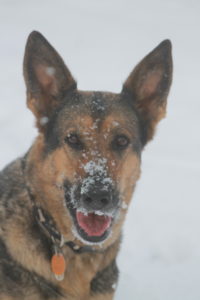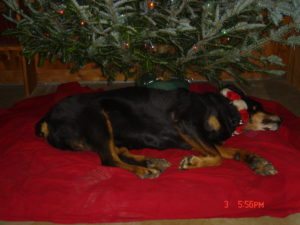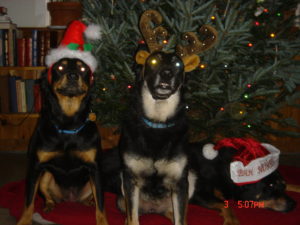‘Tis The Season
So hopefully you made it through the kick off to the holiday season without anything like this happening:

and now it’s time to get ready for the winter season with all the celebrations and cold it brings. I know at our house we have two different attitudes towards the cold when it comes to our dogs. There is our chihuahua, who will be burrowed underneath a blanket for the next 4 months  and our shepherds who will be ecstatic every time it snows.
and our shepherds who will be ecstatic every time it snows.
 Being dog trainers, we follow a lot of social media groups having to do with various aspects of dog training and care. I can tell you that this time of year brings about a lot of debate and heated feelings about how best to take care of your dogs in cold weather. Let me just say right off the bat, that I think a lot of the arguments people have with each other are due to the fact that we don’t differentiate between different types of dogs. We have owned many different breeds of dogs over the years from the chihuahua I mentioned earlier to husky mixes, rottweilers, chow mixes and many more in between and we have seen first hand that they have different needs based on their physical attributes.
Being dog trainers, we follow a lot of social media groups having to do with various aspects of dog training and care. I can tell you that this time of year brings about a lot of debate and heated feelings about how best to take care of your dogs in cold weather. Let me just say right off the bat, that I think a lot of the arguments people have with each other are due to the fact that we don’t differentiate between different types of dogs. We have owned many different breeds of dogs over the years from the chihuahua I mentioned earlier to husky mixes, rottweilers, chow mixes and many more in between and we have seen first hand that they have different needs based on their physical attributes.
Some tips on how to keep your dog happy and warm in the winter
-
Not all coats are created equal:
Dog’s cold tolerance will vary depending on their coat type. Does your dog have very short hair, long hair, a thick undercoat? A dog’s coat is it’s first line of defense against the cold so if they don’t have a nice thick undercoat then make sure not to keep them out for too long.
-
Play Dress-up:
If you have a short hair dog and love to adventure outside in the cold, don’t fret. There are so many options for dog sweaters and jackets nowadays that you can surely find something to help keep them toasty. Bring them to any local pet store such as Weaverville Pet Pantry or Asheville Pet Supply and even try on the gear then you can make sure it fits and remember to think about ease of getting it on and off.
-
Breed History:
If you know your dog’s breed or breeds you can do an internet search and find out some info about where they originally hail from and their purpose. This can give you an idea on whether or not they are bred to be in cold weather.
-
Check the paws:
Dogs with great coats for the snow often have very furry feet as well.Their paws can easily get impacted with snow and ice so make sure to periodically check them. If they do become impacted just bring them inside to a warm place and let it melt. Dog booties are also an option for dogs who want to be out in the snow a lot or for dogs who really just aren’t meant for those kind of conditions. Booties are also a great option if you walk your dog in areas where people use different products to help keep walkways clear as the products can be irritating to sensitive paws. If you don’t opt for booties, just give their paws a wipe when you return home.
-
General health:
General health, body fat stores and activity level can all play a role in how your dog does in the cold. Arthritic and elderly dogs may have more difficulty walking on snow and ice and may be more prone to slipping and falling. Short legged dogs may become colder faster because their bellies and bodies are more likely to come into contact with snow. (Yes, I have actually swept the grass in my yard to make a potty spot for our chihuahua.) Pets with certain diseases like diabetes can have trouble regulating body temperature.
When in doubt, take a break from the cold and go inside and enjoy some hot chocolate! (Not for your dog of course!) Here’s to a safe and happy winter season with your four legged family members!





